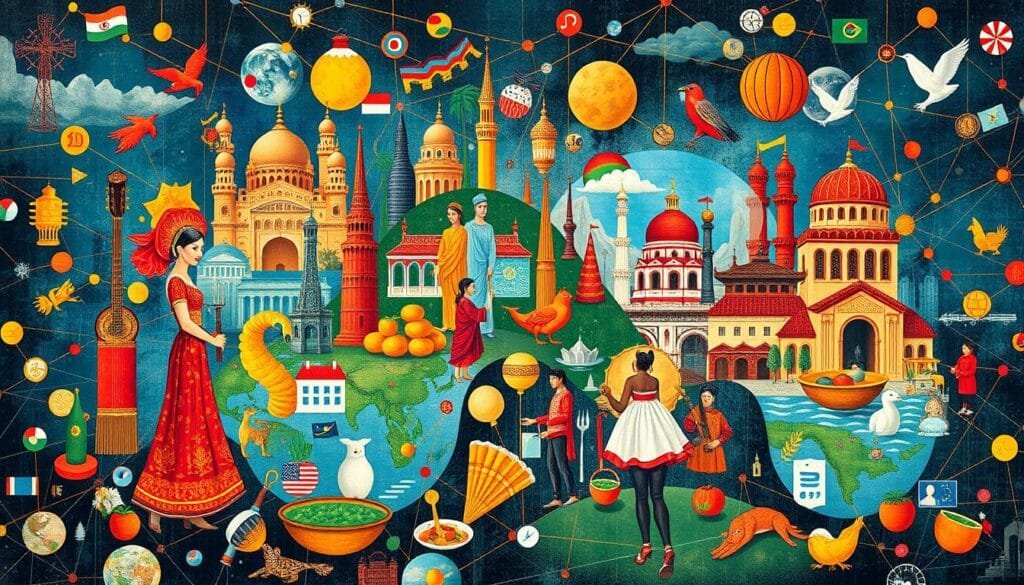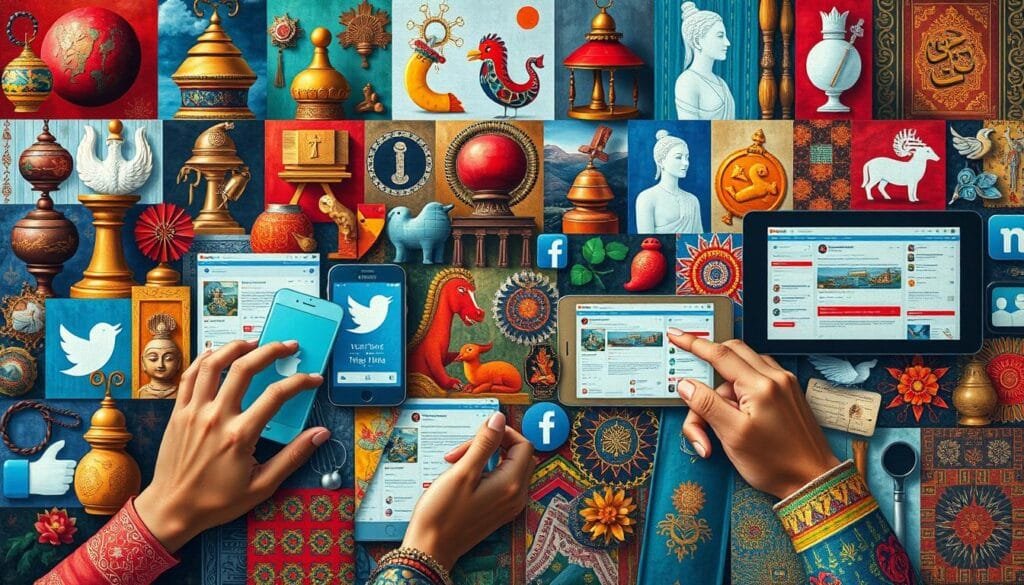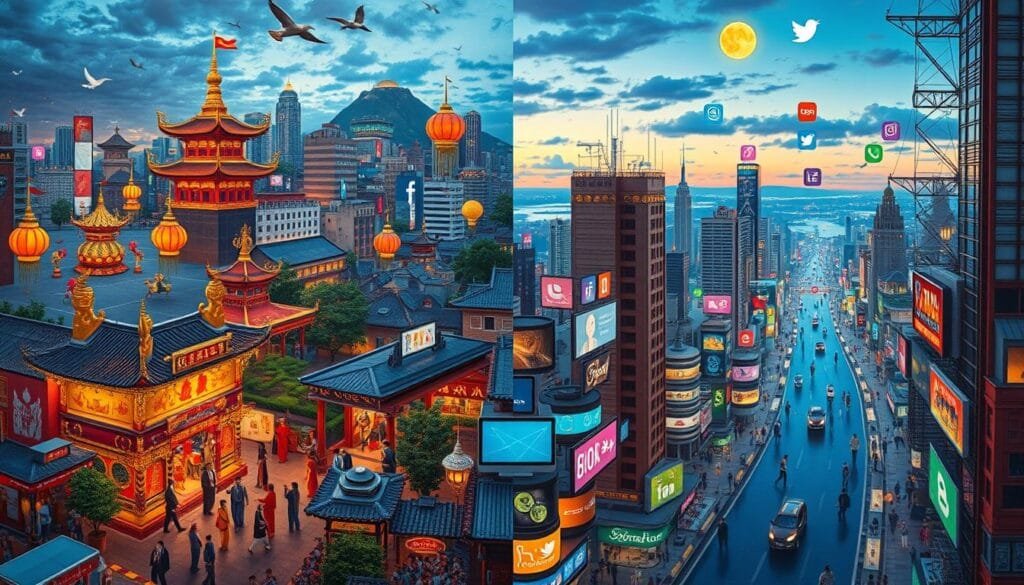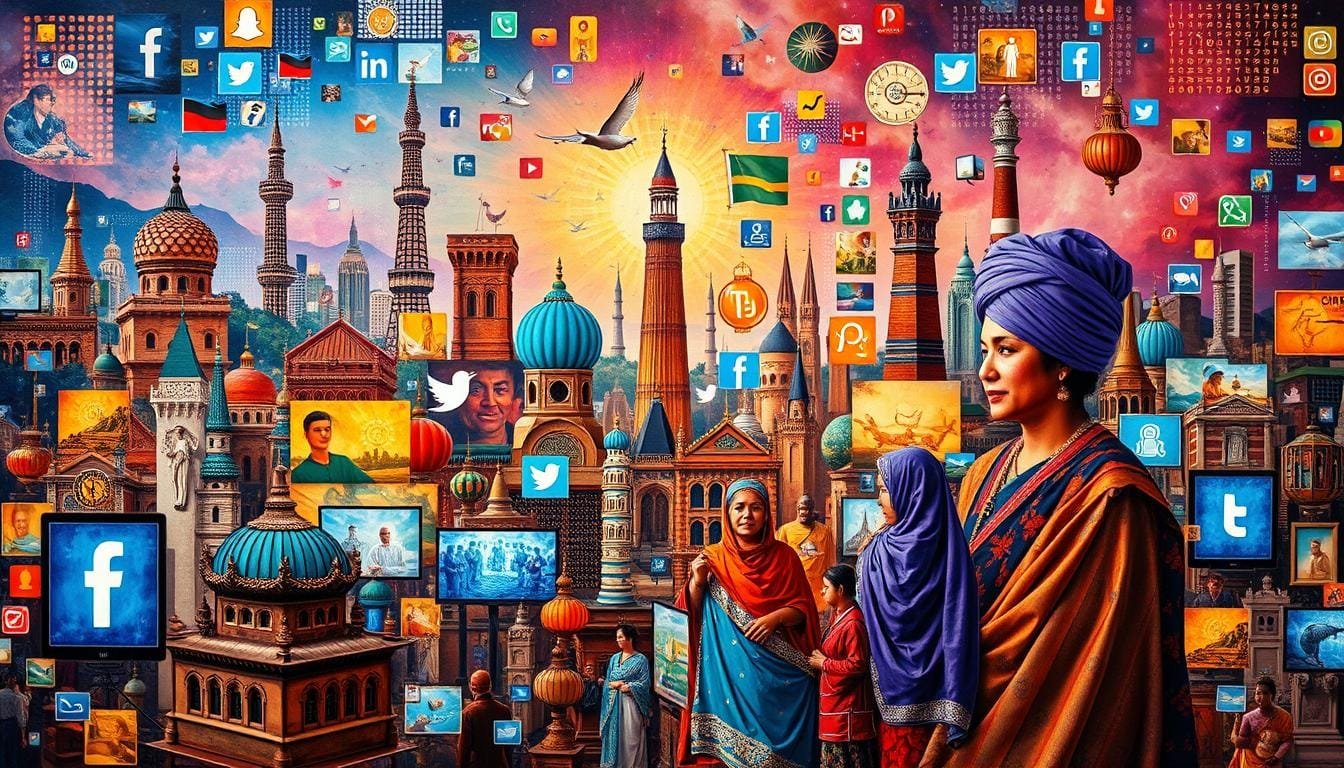Have you ever thought about the link between culture and social media? In the world today, social media boosts cultural exchange and evolution. It’s not just for sharing personal moments but also for shaping how we see global cultures and interact. Social movements like #MeToo and climate change activism show its power. These platforms aren’t just for chatting. They’re where cultural stories and identities get reshaped.
Imagine this: nearly 70% of social media users feel closer to folks from other cultures. Facebook, Instagram, and Twitter let us see and share diverse cultural practices. They break down the walls that kept us apart in the past. But, there’s a downside. False information spreads six times quicker than the truth. And, there’s a risk of misusing other cultures.
This article looks at how social media is changing culture today. We’ll see it as something that brings us together and sometimes splits us apart. We’re diving into how it changes cultural dynamics and redraws the lines of traditional cultural boundaries.
Key Takeaways
- Social media has turned up the volume for voices that often go unheard, sparking cultural change.
- Efforts like #MeToo and fighting climate change get a huge boost from social media.
- About 70% of users feel they connect better with other cultures through social media.
- But, wrong info flies fast on these platforms, up to six times quicker than the truth, creating big problems.
- While social media can keep cultural heritage alive, it also faces the issues of misusing and oversimplifying cultures.
- Some 65% of adults think social media makes political debates even more polarized.
- Mixing worldwide cultural values on social media can help us understand each other better. Yet, it might simplify deep and complex traditional practices.
The Intersection of Culture and Social Media
The relationship between culture and social media is fascinating. It shows how digital spaces both mirror and form our society’s norms and actions. Social media helps us understand cultural changes. It spots both lasting shifts and quick responses to happenings worldwide. Here, we’ll explore how they interact and shape our global community.
Understanding Cultural Shifts through Social Insights
We now get cultural shifts much better, thanks to social media. A deep dive into 842 papers found 85 that were just right. This equals a pick rate of about 10.1%. In these picked studies:
- 44 articles (51.76%) focused on cultural communication on social media.
- 26 were from the psychology field (59.09%).
- 5 articles (11.36%) looked at it through neuroscience.
- 27 articles mixed psychology and neuroscience, but few tackled cross-cultural talks directly.
These findings highlight social media’s big role in cultural talks. Trends in integration show more use of terms like “acculturation” and “cultural evolution”. This points to the rising importance of digital platforms in cultural swaps.
Examples of Cultural Adaptation on Social Media Platforms
On platforms like TikTok and Instagram, we see digital cultural changes. Here, traditional content gets a twist to click with worldwide viewers. Viral trends often mix cultures, showing how they blend and grow online. Let’s look at some key stats:
| Statistic | Impact |
|---|---|
| 70% of people believe technology shifts their cultural identity | Underlines the strong effect of social media on shaping personal identity |
| 90% of millennials and Gen Z express culture through social media | Shows digital spaces are central to today’s cultural expressions |
| 1.3 billion users join Facebook groups | Points out how the platform helps create cultural interest groups online |
| 80% of teachers see more joining online classes | Indicates digital spaces’ role in cultural learning and exchanges in education |
| 5 billion videos are watched on YouTube daily | Proves high interest in different cultural content |
Through these platforms, digital cultural adaptation is clear. Users remake traditional content to appeal to varied audiences. This leads to a worldwide culture that’s more connected and mixed.
The Role of Social Media in Cultural Exchange
Social media acts as a powerful bridge for cultural exchange. It lets people from different backgrounds share and learn about each other’s cultures. Stories, art, and direct chats make cross-cultural connections easier than ever.

Sites like Facebook and YouTube are key places for cultural exchanges. They have communities and channels that help us understand world cultures better. Qatari youth, for example, use Instagram, WhatsApp, and Twitter. They connect with cultural and political discussions this way.
Social media helps us navigate through various media settings. It allows us to express our national and global identities. For minority communities, like Hungary’s Roma, Instagram and TikTok offer a space to share their culture and fight stereotypes. Also, social media helps us understand local cultures through information and conversations.
In digital settings, influencers shape our cultural identities. They influence how we see different cultures and what we aspire to be. This shows how powerful visual stories can be for us.
User Generated Content (UGC) has helped grow the Entertainment industry focused on social media. During global festivals, social media activity can jump by 50%. This shows how social media cultural exchange creates lively global conversations.
| Platform | Primary Cultural Function | Impact on Users |
|---|---|---|
| Visual storytelling of cultural heritage | Enhances cultural appreciation | |
| YouTube | Discussions of cultural traditions | Provides immersive experiences |
| TikTok | Showcase cultural heritage | Challenges stereotypes |
Using these platforms shows the big impact of social media on global communication. Even with language barriers, social media enables quick chats across cultures. It leads to a global exchange of ideas and deeper cultural understanding.
How Does Culture Involve Social Media Insights
The world is quickly becoming digital, and the mix of culture and social media is key to understanding how societies work. By looking into what social media tells us about culture, companies can make better plans. They can connect more closely with the people they want to reach. This part talks about how cultural insights differ from just spotting trends. It also covers why cultural context matters and what challenges and opportunities come with finding these insights.
Cultural Insights vs. Trendspotting
Distinguishing cultural insights from trendspotting is vital for using social media effectively. Trendspotting is about seeing new patterns. Cultural insights go deeper, looking at the values and reasons behind these trends. An example is, data from Nielsen says the average American is on social media for more than four hours a day. This shows why a deeper look into culture is needed, beyond just what’s currently popular.
Trendspotting is about what’s trending now. Cultural insights aim to understand why people feel a connection to certain things. This way, we can make strategies that truly speak to our audience’s core cultural values.
The Importance of Cultural Context in Social Intelligence
Using cultural context in business is crucial for real connections. Social media acts like a cultural soup, mixing different views from around the world. Data from Statista shows that 68% of shoppers say social media influencers sway their buying choices. This highlights how important cultural insights are for creating marketing plans. For a deeper grasp, digital ethnography tools are quite helpful.
Social media content merges various cultural elements, with over 50% of users exploring cultural content from other countries. This shows how vital it is to understand cultural contexts for businesses. Doing so leads to meaningful connections and better strategies.
Challenges and Potentials in Uncovering Cultural Insights
Finding cultural insights in social media is tough due to lots of unorganized data. Not every trend is rooted in deeper cultural values. So, sorting through this data requires advanced tools and methods. Also, social media changes fast, making it hard to keep insights up-to-date and relevant.

Yet, the benefits are huge. Good cultural insights can help brands create strategies that last and resonate. For example, many of the highest-earning movies are adaptations, showing how media benefits from cultural mixing. Global views from varied audiences can lead to new ideas and more inclusive business approaches. Understanding cultural contexts helps businesses engage better, building loyal and diverse customer groups.
To learn more about how social media affects society and its wider effects, you can read this detailed study here.
Positive and Negative Impacts of Social Media on Culture
Social media deeply affects our culture. It promotes cultural diversity but also triggers controversy. This section looks at how social media impacts culture.

Cultural Dissemination and Diversity Promotion
Social media allows people to connect worldwide. Users from various communities can share and interact. Struggling artists use it to get noticed globally.
During the COVID-19 pandemic, social media was key for artists like singers and dancers. It let them share their work despite the crisis.
About two-thirds of teens explore new viewpoints or back social causes via social media, per a 2018 survey.
| Positive Impacts | Negative Impacts |
|---|---|
|
|
Controversy and Division through Social Media Content
Social media can divide people and spread false info. This leads to conflicts that widen cultural gaps. A study found 73% worry about fake news on social media.
The increase in cyberbullying is serious. Nearly half of all teens have been bullied online. This results in more drug use and mental health issues. LGBTQ+ and BIPOC teens face more cyberbullying, showing a need for safer online spaces.
Social media can hurt self-esteem and body image among youth. Teens see harmful content and are harassed online. This is worse for girls than boys. Too much screen time also disrupts sleep and causes stress, impacting mental health.
When discussing impacts of social media on culture, we must see both sides. Social media boosts cultural diversity yet can cause controversy. Balancing these effects as social platforms grow is key.
Conclusion
We have learned how deeply culture and social media are intertwined. Social networks shape and reflect our cultural identities. They show the power of social media in our lives.
This article has shown that cultural shifts can be understood through social media. This insight helps businesses and policymakers. For example, the #BlackLivesMatter movement shows social media’s impact on culture.
Social media is key for understanding global culture. In 2020, social media users grew by 11%, and time spent increased by 40%. This shows the role of digital spaces in cultural exchange and the need to use social media wisely for cultural appreciation.
FAQ
How does culture influence social media?
Social media plays a key role in shaping and sharing culture. It lets people exchange ideas and values. This interaction influences the growth and connection of different cultures. Social media helps blend cultures and highlights unique cultural aspects.
What are some examples of cultural adaptation on social media platforms?
TikTok and Instagram show how culture adapts on social media. They turn traditional content into something new and exciting. This can start global trends that mix cultures together.
How does social media promote cultural exchange?
Social media is a powerful tool for cultural exchange. It allows people from diverse backgrounds to share and explore different cultures. Through stories, art, and direct communication, it connects cultures. Facebook and YouTube, for example, create spaces where people can engage with varied cultural content.
How do we distinguish between trendspotting and cultural insights on social media?
Understanding the difference starts with knowing the depth of cultural insights. They look into society’s core values and motivations. This is deeper than just spotting trends. Cultural insights help build lasting strategies that deeply connect with society.
What are the challenges in uncovering cultural insights through social media?
Finding cultural insights on social media is tough. It’s due to the complexity of culture and the vast, chaotic data online. Success needs careful analysis and a deep grasp of digital human behavior and online listening.
What are the positive impacts of social media on culture?
Social media has brought many good things to culture. It makes sharing information easier and supports cultural diversity. It also allows more diverse cultural exchanges than ever before.
What are the negative impacts of social media on culture?
Social media can also harm culture. It may increase division and spread false information. These issues can make cultural divides worse. It’s important to tackle these problems to make online culture better.
How can businesses use cultural insights from social media?
Businesses can use social media insights to better appreciate culture and manage global interactions. These insights help in making sustainable strategies. They also provide a deep understanding of consumer behavior in society.
